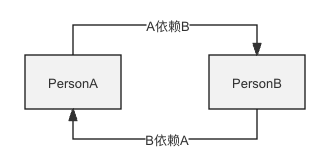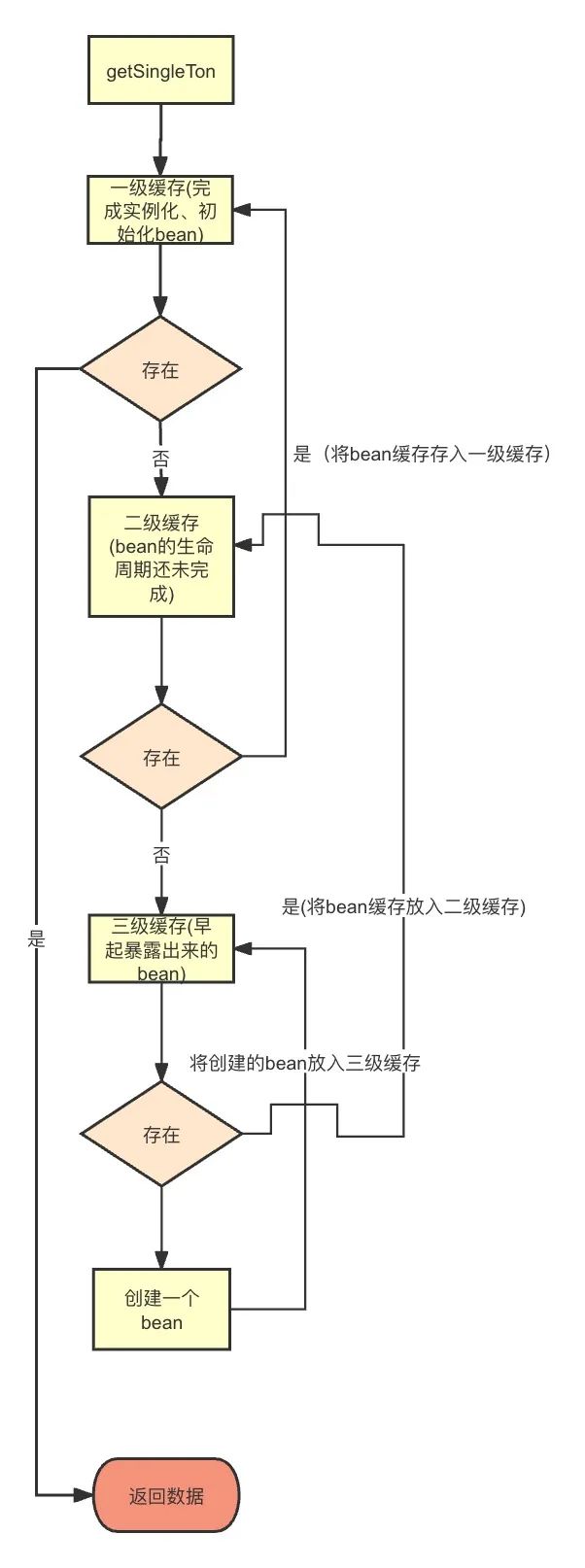1. 前言
在日常开发中,Bean之间的循环依赖非常常见,Spring 已经帮我们做到使用无感知处理,那么 Spring 是如何实现的呢?
2. 循环依赖简介
2.1 什么是循环依赖
循环依赖是指两个或多个对象存在相互依赖、相互引用的关系,而这种引用形成一个环时,就会出现循环引用,如图:
 图片
图片
public class PersonA {
@Autowired
private PersonB personB;
}public class PersonB {
@Autowired
private PersonA personA;
}2.2 Spring 处理循环依赖的前提条件
1.相互依赖的 Bean 必须为单利;
因为如果每次请求都创建一个 Bean,那么在处理循环依赖的时候,每次都会产生一个新的 Bean 实例,由于没有全局的实例 Bean 缓存,则无法处理循环依赖
2.依赖注入的方式不能都是构造函数注入的方式。
使用构造函数注入,Bean 实例在构造函数没有完全被调用时是不会创建的;因为 PersonA 引用 PersonB,PersonB 又引用 PersonA,两者都无法进行初始化,产生了死锁
3. 三级缓存原理
3.1 什么是三级缓存
Spring 是通过三级缓存的方式处理循环依赖,三级缓存是 Spring Bean 在各个阶段的缓存
一级缓存(SingletonObjects):
存放已经完全实例化、初始化的bean,实现了单利bean只会实例化和初始化一次
二级缓存(EarlySingletonObjects):
存放早期暴露出来的Bean对象,bean的生命周期还未完成(未完成属性注入与初始化的bean)
三级缓存(SingletonFactories):
三级缓存中存储的是单利工厂缓存,通过调用该对象的 GetObject 方法,可以获取到早期暴露出去的 Bean;在该 Bean 要被其他 Bean 引用时,Spring 就会用工厂对象创建出该 Bean 的实例对象,最终当该 Bean 完成构造的所有步骤后就会将该 Bean 放入到一级缓存中
/** 一级缓存 */
private final Map<String, Object> singletonObjects = new ConcurrentHashMap<String, Object>(256);
/** 二级缓存 */
private final Map<String, Object> earlySingletonObjects = new HashMap<String, Object>(16);
/** 三级缓存 */
private final Map<String, ObjectFactory<?>> singletonFactories = new HashMap<String, ObjectFactory<?>>(16);3.2 三级缓存流程
 图片
图片
3.3 三级缓存源码解析
创建 Bean 主要的方法是 AbstractBeanFactory.doGetBean 方法
protected <T> T doGetBean( String name, @Nullable Class<T> requiredType, @Nullable Object[] args, boolean typeCheckOnly) throws BeansException {
// 获取bean的规范名称
String beanName = transformedBeanName(name);
Object bean;
// 从各级缓存中获取bean对象
Object sharedInstance = getSingleton(beanName);
// 跟factoryBean相关判断
if (sharedInstance != null && args == null) {
...
}
// 获取factorybean的真是bean
//若为普通bean则直接返回对象
bean = getObjectForBeanInstance(sharedInstance, name, beanName, null);
}
......
// 创建单利bean对象
if (mbd.isSingleton()) {
sharedInstance = getSingleton(beanName, () -> {
try {
// 创建bean
return createBean(beanName, mbd, args);
} catch (BeansException ex) {
// Explicitly remove instance from singleton cache: It might have been put there
// eagerly by the creation process, to allow for circular reference resolution.
// Also remove any beans that received a temporary reference to the bean. destroySingleton(beanName);
throw ex;
}
});
bean = getObjectForBeanInstance(sharedInstance, name, beanName, mbd);
}
......
// 返回bean对象 return (T) bean; }我们看两个比较重要获取 Bean 的方法 GetSingleton()
// 这个方法主要是三级缓存容器,思路大概是:从一级缓存查询,若找不到去二级缓存查询,还是不存在则去三级缓存,若三级缓存找到了,则将bean放入二级缓存中
protected Object getSingleton(String beanName, boolean allowEarlyReference) {
// 从一级缓存中查找bean
Object singletonObject = this.singletonObjects.get(beanName);
// 判断一级缓存查找不到bean && bean是否处于创建中,成立,则进入循环依赖
if (singletonObject == null && isSingletonCurrentlyInCreation(beanName)) {
synchronized (this.singletonObjects) {
// 从二级缓存中查找
singletonObject = this.earlySingletonObjects.get(beanName);
// 二级缓存未查询到 && 是否允许获取早期引用
if (singletonObject == null && allowEarlyReference) {
// 从三级缓存查询
ObjectFactory<?> singletonFactory = this.singletonFactories.get(beanName);
// 三级缓存存在bean
if (singletonFactory != null) {
// 获取bean实例
singletonObject = singletonFactory.getObject();
// 从三级缓存升级到二级缓存,
this.earlySingletonObjects.put(beanName, singletonObject);
// 三级缓存中移除
this.singletonFactories.remove(beanName);
}
}
}
}
// 返回bean
return singletonObject;
}public Object getSingleton(String beanName, ObjectFactory<?> singletonFactory) {
Assert.notNull(beanName, "Bean name must not be null");
synchronized (this.singletonObjects) {
// 从一级缓存中获取对应bean
Object singletonObject = this.singletonObjects.get(beanName);
// 若bean不存在
if (singletonObject == null) {
// 当前正在销毁bean,不能创建
if (this.singletonsCurrentlyInDestruction) {
throw new BeanCreationNotAllowedException(beanName, "Singleton bean creation not allowed while singletons of this factory are in destruction " + "(Do not request a bean from a BeanFactory in a destroy method implementation!)");
}
if (logger.isDebugEnabled()) {
logger.debug("Creating shared instance of singleton bean '" + beanName + "'");
}
// 创建前检查,记录正在加载状态
beforeSingletonCreation(beanName);
boolean newSingleton = false;
boolean recordSuppressedExceptions = (this.suppressedExceptions == null);
// 如果当前没有异常,初始化异常集合
if (recordSuppressedExceptions) {
this.suppressedExceptions = new LinkedHashSet<>();
}
try {
// 执行匿名内部类方法
singletonObject = singletonFactory.getObject();
newSingleton = true;
}
catch(IllegalStateException ex){
// 执行getObject方法创建bean
singletonObject = this.singletonObjects.get(beanName);
if (singletonObject == null) {
throw ex;
}
} catch(BeanCreationException ex){
if (recordSuppressedExceptions) {
or (Exception suppressedException : this.suppressedExceptions) {
ex.addRelatedCause(suppressedException);
}
}
throw ex;
} finally{
if (recordSuppressedExceptions) {
this.suppressedExceptions = null;
}
// 单例bean创建完成后,容器移除bean
afterSingletonCreation(beanName);
}
// newSingleton为true时,表示bean创建成功
// 判断是否为新的完成整bean
if (newSingleton) {
// 将bean存入一级缓存中
addSingleton(beanName, singletonObject);
}
}
return singletonObject;
}
}添加与清理缓存
// 将bean放入一级缓存切清楚二级、三级缓存
protected void addSingleton(String beanName, Object singletonObject) {
synchronized (this.singletonObjects) {xw
// 添加到一级缓存中
this.singletonObjects.put(beanName, singletonObject);
// 从三级缓存中移除
this.singletonFactories.remove(beanName);
// 从二级缓存中移除
this.earlySingletonObjects.remove(beanName);
// 放入已注册的单利池中
this.registeredSingletons.add(beanName);
}
}// 添加到三级缓存
protected void addSingletonFactory(String beanName, ObjectFactory<?> singletonFactory) {
synchronized (this.singletonObjects) {
// 若一级缓存不存在bean实例
if (!this.singletonObjects.containsKey(beanName)) {
// 添加到三级缓存
this.singletonFactories.put(beanName, singletonFactory);
// 从第二级缓存删除
this.earlySingletonObjects.remove(beanName);
// 放入已注册的单例池里
this.registeredSingletons.add(beanName);
}
}4.总结
Spring 循环依赖是通过map缓存进行处理的,其中包括一级、二级、三级缓存,作用如下:
- 一级缓存SingletonObjects实例化、初始化实例。
- 二级缓存EarlySingletonObjects存放的是早期的 Bean ,半成品还未初始化的 bean。
- 三级缓存SingletonFactories是一个对象工厂,用于创建对象,然后放入到二级缓存中。同时对象如果存在 Aop 代理,那么返回的对象就是代理对象。
参考文献
https://www.51cto.com/article/702892.html








































